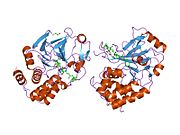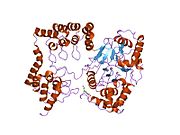PPP1CA
| PPP1CA | |||||||||||||||||||||||||||||||||||||||||||||||||||
|---|---|---|---|---|---|---|---|---|---|---|---|---|---|---|---|---|---|---|---|---|---|---|---|---|---|---|---|---|---|---|---|---|---|---|---|---|---|---|---|---|---|---|---|---|---|---|---|---|---|---|---|
 | |||||||||||||||||||||||||||||||||||||||||||||||||||
| |||||||||||||||||||||||||||||||||||||||||||||||||||
| Identifiers | |||||||||||||||||||||||||||||||||||||||||||||||||||
| Aliases | PPP1CA, PP-1A, PP1A, PP1alpha, PPP1A, protein phosphatase 1 catalytic subunit alpha | ||||||||||||||||||||||||||||||||||||||||||||||||||
| External IDs | OMIM: 176875; MGI: 103016; HomoloGene: 105262; GeneCards: PPP1CA; OMA:PPP1CA - orthologs | ||||||||||||||||||||||||||||||||||||||||||||||||||
| |||||||||||||||||||||||||||||||||||||||||||||||||||
| |||||||||||||||||||||||||||||||||||||||||||||||||||
| |||||||||||||||||||||||||||||||||||||||||||||||||||
| |||||||||||||||||||||||||||||||||||||||||||||||||||
| |||||||||||||||||||||||||||||||||||||||||||||||||||
| Wikidata | |||||||||||||||||||||||||||||||||||||||||||||||||||
| |||||||||||||||||||||||||||||||||||||||||||||||||||
Serine/threonine-protein phosphatase PP1-alpha catalytic subunit is an enzyme that in humans is encoded by the PPP1CA gene.
Function
The protein encoded by this gene is one of the three catalytic subunits of protein phosphatase 1 (PP1). PP1 is a serine/threonine specific protein phosphatase known to be involved in the regulation of a variety of cellular processes, such as cell division, glycogen metabolism, muscle contractility, protein synthesis, and HIV-1 viral transcription. Increased PP1 activity has been observed in the end stage of heart failure. Studies in both human and mice suggest that PP1 is an important regulator of cardiac function. Three alternatively spliced transcript variants encoding different isoforms have been found for this gene.[5]
Interactive pathway map
Click on genes, proteins and metabolites below to link to respective articles.[§ 1]


- ^ The interactive pathway map can be edited at WikiPathways: "NicotineDopaminergic_WP1602".
Interactions
PPP1CA has been shown to interact with:
References
- ^ a b c GRCh38: Ensembl release 89: ENSG00000172531 – Ensembl, May 2017
- ^ a b c GRCm38: Ensembl release 89: ENSMUSG00000040385 – Ensembl, May 2017
- ^ "Human PubMed Reference:". National Center for Biotechnology Information, U.S. National Library of Medicine.
- ^ "Mouse PubMed Reference:". National Center for Biotechnology Information, U.S. National Library of Medicine.
- ^ "Entrez Gene: PPP1CA protein phosphatase 1, catalytic subunit, alpha isoform".
- ^ Tanji C, Yamamoto H, Yorioka N, Kohno N, Kikuchi K, Kikuchi A (October 2002). "A-kinase anchoring protein AKAP220 binds to glycogen synthase kinase-3beta (GSK-3beta ) and mediates protein kinase A-dependent inhibition of GSK-3beta". J. Biol. Chem. 277 (40): 36955–61. doi:10.1074/jbc.M206210200. PMID 12147701.
- ^ Schillace RV, Scott JD (March 1999). "Association of the type 1 protein phosphatase PP1 with the A-kinase anchoring protein AKAP220". Curr. Biol. 9 (6): 321–4. Bibcode:1999CBio....9..321S. doi:10.1016/s0960-9822(99)80141-9. PMID 10209101. S2CID 9188320.
- ^ a b Ayllón V, Cayla X, García A, Fleischer A, Rebollo A (July 2002). "The anti-apoptotic molecules Bcl-xL and Bcl-w target protein phosphatase 1alpha to Bad". Eur. J. Immunol. 32 (7): 1847–55. doi:10.1002/1521-4141(200207)32:7<1847::AID-IMMU1847>3.0.CO;2-7. PMID 12115603.
- ^ Liu Y, Virshup DM, White RL, Hsu LC (November 2002). "Regulation of BRCA1 phosphorylation by interaction with protein phosphatase 1alpha". Cancer Res. 62 (22): 6357–61. PMID 12438214.
- ^ Ajuh P, Kuster B, Panov K, Zomerdijk JC, Mann M, Lamond AI (December 2000). "Functional analysis of the human CDC5L complex and identification of its components by mass spectrometry". EMBO J. 19 (23): 6569–81. doi:10.1093/emboj/19.23.6569. PMC 305846. PMID 11101529.
- ^ a b Ajuh PM, Browne GJ, Hawkes NA, Cohen PT, Roberts SG, Lamond AI (February 2000). "Association of a protein phosphatase 1 activity with the human factor C1 (HCF) complex". Nucleic Acids Res. 28 (3): 678–86. doi:10.1093/nar/28.3.678. PMC 102561. PMID 10637318.
- ^ Marx SO, Kurokawa J, Reiken S, Motoike H, D'Armiento J, Marks AR, Kass RS (January 2002). "Requirement of a macromolecular signaling complex for beta adrenergic receptor modulation of the KCNQ1-KCNE1 potassium channel". Science. 295 (5554): 496–9. Bibcode:2002Sci...295..496M. doi:10.1126/science.1066843. PMID 11799244. S2CID 6153394.
- ^ Wang H, Brautigan DL (December 2002). "A novel transmembrane Ser/Thr kinase complexes with protein phosphatase-1 and inhibitor-2". J. Biol. Chem. 277 (51): 49605–12. doi:10.1074/jbc.M209335200. PMID 12393858.
- ^ Sagara J, Higuchi T, Hattori Y, Moriya M, Sarvotham H, Shima H, Shirato H, Kikuchi K, Taniguchi S (November 2003). "Scapinin, a putative protein phosphatase-1 regulatory subunit associated with the nuclear nonchromatin structure". J. Biol. Chem. 278 (46): 45611–9. doi:10.1074/jbc.M305227200. PMID 12925532.
- ^ Hung WJ, Roberson RS, Taft J, Wu DY (May 2003). "Human BAG-1 proteins bind to the cellular stress response protein GADD34 and interfere with GADD34 functions". Mol. Cell. Biol. 23 (10): 3477–86. doi:10.1128/mcb.23.10.3477-3486.2003. PMC 164759. PMID 12724406.
- ^ a b Wu DY, Tkachuck DC, Roberson RS, Schubach WH (August 2002). "The human SNF5/INI1 protein facilitates the function of the growth arrest and DNA damage-inducible protein (GADD34) and modulates GADD34-bound protein phosphatase-1 activity". J. Biol. Chem. 277 (31): 27706–15. doi:10.1074/jbc.M200955200. PMID 12016208.
- ^ Connor JH, Weiser DC, Li S, Hallenbeck JM, Shenolikar S (October 2001). "Growth arrest and DNA damage-inducible protein GADD34 assembles a novel signaling complex containing protein phosphatase 1 and inhibitor 1". Mol. Cell. Biol. 21 (20): 6841–50. doi:10.1128/MCB.21.20.6841-6850.2001. PMC 99861. PMID 11564868.
- ^ Jin Q, van Eynde A, Beullens M, Roy N, Thiel G, Stalmans W, Bollen M (August 2003). "The protein phosphatase-1 (PP1) regulator, nuclear inhibitor of PP1 (NIPP1), interacts with the polycomb group protein, embryonic ectoderm development (EED), and functions as a transcriptional repressor". J. Biol. Chem. 278 (33): 30677–85. doi:10.1074/jbc.M302273200. PMID 12788942.
- ^ Hsieh-Wilson LC, Allen PB, Watanabe T, Nairn AC, Greengard P (April 1999). "Characterization of the neuronal targeting protein spinophilin and its interactions with protein phosphatase-1". Biochemistry. 38 (14): 4365–73. doi:10.1021/bi982900m. PMID 10194355.
- ^ Tan SL, Tareen SU, Melville MW, Blakely CM, Katze MG (September 2002). "The direct binding of the catalytic subunit of protein phosphatase 1 to the PKR protein kinase is necessary but not sufficient for inactivation and disruption of enzyme dimer formation". J. Biol. Chem. 277 (39): 36109–17. doi:10.1074/jbc.M205109200. PMID 12138106.
Further reading
- Cohen PT (2002). "Protein phosphatase 1--targeted in many directions". J. Cell Sci. 115 (Pt 2): 241–56. doi:10.1242/jcs.115.2.241. PMID 11839776.
- Barker HM, Jones TA, da Cruz e Silva EF, Spurr NK, Sheer D, Cohen PT (1990). "Localization of the gene encoding a type I protein phosphatase catalytic subunit to human chromosome band 11q13". Genomics. 7 (2): 159–66. doi:10.1016/0888-7543(90)90536-4. PMID 2161401.
- Carrey EA, Campbell DG, Hardie DG (1986). "Phosphorylation and activation of hamster carbamyl phosphate synthetase II by cAMP-dependent protein kinase. A novel mechanism for regulation of pyrimidine nucleotide biosynthesis". EMBO J. 4 (13B): 3735–42. doi:10.1002/j.1460-2075.1985.tb04142.x. PMC 554725. PMID 4092695.
- Saadat M, Mizuno Y, Kikuchi K, Yoshida MC (1995). "Comparative mapping of the gene encoding the catalytic subunit of protein phosphatase type 1 alpha (PPP1CA) to human, rat, and mouse chromosomes". Cytogenet. Cell Genet. 70 (1–2): 55–7. doi:10.1159/000133991. PMID 7736790.
- Durfee T, Becherer K, Chen PL, Yeh SH, Yang Y, Kilburn AE, Lee WH, Elledge SJ (1993). "The retinoblastoma protein associates with the protein phosphatase type 1 catalytic subunit". Genes Dev. 7 (4): 555–69. doi:10.1101/gad.7.4.555. PMID 8384581.
- Song Q, Khanna KK, Lu H, Lavin MF (1993). "Cloning and characterization of a human protein phosphatase 1-encoding cDNA". Gene. 129 (2): 291–5. doi:10.1016/0378-1119(93)90282-8. PMID 8392016.
- Bonaldo MF, Lennon G, Soares MB (1997). "Normalization and subtraction: two approaches to facilitate gene discovery". Genome Res. 6 (9): 791–806. doi:10.1101/gr.6.9.791. PMID 8889548.
- Kwon YG, Huang HB, Desdouits F, Girault JA, Greengard P, Nairn AC (1997). "Characterization of the interaction between DARPP-32 and protein phosphatase 1 (PP-1): DARPP-32 peptides antagonize the interaction of PP-1 with binding proteins". Proc. Natl. Acad. Sci. U.S.A. 94 (8): 3536–41. Bibcode:1997PNAS...94.3536K. doi:10.1073/pnas.94.8.3536. PMC 20474. PMID 9108011.
- Colbran RJ, Bass MA, McNeill RB, Bollen M, Zhao S, Wadzinski BE, Strack S (1997). "Association of brain protein phosphatase 1 with cytoskeletal targeting/regulatory subunits". J. Neurochem. 69 (3): 920–9. doi:10.1046/j.1471-4159.1997.69030920.x. PMID 9282913. S2CID 34789662.
- Allen PB, Kwon YG, Nairn AC, Greengard P (1998). "Isolation and characterization of PNUTS, a putative protein phosphatase 1 nuclear targeting subunit". J. Biol. Chem. 273 (7): 4089–95. doi:10.1074/jbc.273.7.4089. PMID 9461602.
- Zhang J, Zhang L, Zhao S, Lee EY (1998). "Identification and characterization of the human HCG V gene product as a novel inhibitor of protein phosphatase-1". Biochemistry. 37 (47): 16728–34. doi:10.1021/bi981169g. PMID 9843442.
- Neumann J, Maas R, Bokník P, Jones LR, Zimmermann N, Scholz H (1999). "Pharmacological characterization of protein phosphatase activities in preparations from failing human hearts". J. Pharmacol. Exp. Ther. 289 (1): 188–93. PMID 10087003.
- Schillace RV, Scott JD (1999). "Association of the type 1 protein phosphatase PP1 with the A-kinase anchoring protein AKAP220". Curr. Biol. 9 (6): 321–4. Bibcode:1999CBio....9..321S. doi:10.1016/S0960-9822(99)80141-9. PMID 10209101. S2CID 9188320.
- Takahashi M, Shibata H, Shimakawa M, Miyamoto M, Mukai H, Ono Y (1999). "Characterization of a novel giant scaffolding protein, CG-NAP, that anchors multiple signaling enzymes to centrosome and the golgi apparatus". J. Biol. Chem. 274 (24): 17267–74. doi:10.1074/jbc.274.24.17267. PMID 10358086.
- McAvoy T, Allen PB, Obaishi H, Nakanishi H, Takai Y, Greengard P, Nairn AC, Hemmings HC (1999). "Regulation of neurabin I interaction with protein phosphatase 1 by phosphorylation". Biochemistry. 38 (39): 12943–9. doi:10.1021/bi991227d. PMID 10504266.
- Yoshida K, Watanabe M, Kato H, Dutta A, Sugano S (1999). "BH-protocadherin-c, a member of the cadherin superfamily, interacts with protein phosphatase 1 alpha through its intracellular domain". FEBS Lett. 460 (1): 93–8. doi:10.1016/S0014-5793(99)01309-5. PMID 10571067. S2CID 24377126.
- Yang J, Hurley TD, DePaoli-Roach AA (2000). "Interaction of inhibitor-2 with the catalytic subunit of type 1 protein phosphatase. Identification of a sequence analogous to the consensus type 1 protein phosphatase-binding motif". J. Biol. Chem. 275 (30): 22635–44. doi:10.1074/jbc.M003082200. PMID 10807923.
- Ayllón V, Martínez-A C, García A, Cayla X, Rebollo A (2000). "Protein phosphatase 1alpha is a Ras-activated Bad phosphatase that regulates interleukin-2 deprivation-induced apoptosis". EMBO J. 19 (10): 2237–46. doi:10.1093/emboj/19.10.2237. PMC 384373. PMID 10811615.
- Boudrez A, Beullens M, Groenen P, Van Eynde A, Vulsteke V, Jagiello I, Murray M, Krainer AR, Stalmans W, Bollen M (2000). "NIPP1-mediated interaction of protein phosphatase-1 with CDC5L, a regulator of pre-mRNA splicing and mitotic entry". J. Biol. Chem. 275 (33): 25411–7. doi:10.1074/jbc.M001676200. PMID 10827081.
- Helps NR, Luo X, Barker HM, Cohen PT (2001). "NIMA-related kinase 2 (Nek2), a cell-cycle-regulated protein kinase localized to centrosomes, is complexed to protein phosphatase 1". Biochem. J. 349 (Pt 2): 509–18. doi:10.1042/0264-6021:3490509. PMC 1221174. PMID 10880350.
- v
- t
- e
-
 1fjm: PROTEIN SERINE/THREONINE PHOSPHATASE-1 (ALPHA ISOFORM, TYPE I) COMPLEXED WITH MICROCYSTIN-LR TOXIN
1fjm: PROTEIN SERINE/THREONINE PHOSPHATASE-1 (ALPHA ISOFORM, TYPE I) COMPLEXED WITH MICROCYSTIN-LR TOXIN -
 1it6: CRYSTAL STRUCTURE OF THE COMPLEX BETWEEN CALYCULIN A AND THE CATALYTIC SUBUNIT OF PROTEIN PHOSPHATASE 1
1it6: CRYSTAL STRUCTURE OF THE COMPLEX BETWEEN CALYCULIN A AND THE CATALYTIC SUBUNIT OF PROTEIN PHOSPHATASE 1 -
 1jk7: CRYSTAL STRUCTURE OF THE TUMOR-PROMOTER OKADAIC ACID BOUND TO PROTEIN PHOSPHATASE-1
1jk7: CRYSTAL STRUCTURE OF THE TUMOR-PROMOTER OKADAIC ACID BOUND TO PROTEIN PHOSPHATASE-1 -
 1s70: Complex between protein ser/thr phosphatase-1 (delta) and the myosin phosphatase targeting subunit 1 (MYPT1)
1s70: Complex between protein ser/thr phosphatase-1 (delta) and the myosin phosphatase targeting subunit 1 (MYPT1) -
 1u32: Crystal structure of a Protein Phosphatase-1: Calcineurin Hybrid Bound to Okadaic Acid
1u32: Crystal structure of a Protein Phosphatase-1: Calcineurin Hybrid Bound to Okadaic Acid -
 2bcd: X-ray crystal structure of Protein Phosphatase-1 with the marine toxin motuporin bound
2bcd: X-ray crystal structure of Protein Phosphatase-1 with the marine toxin motuporin bound -
 2bdx: X-ray Crystal Structure of dihydromicrocystin-LA bound to Protein Phosphatase-1
2bdx: X-ray Crystal Structure of dihydromicrocystin-LA bound to Protein Phosphatase-1























